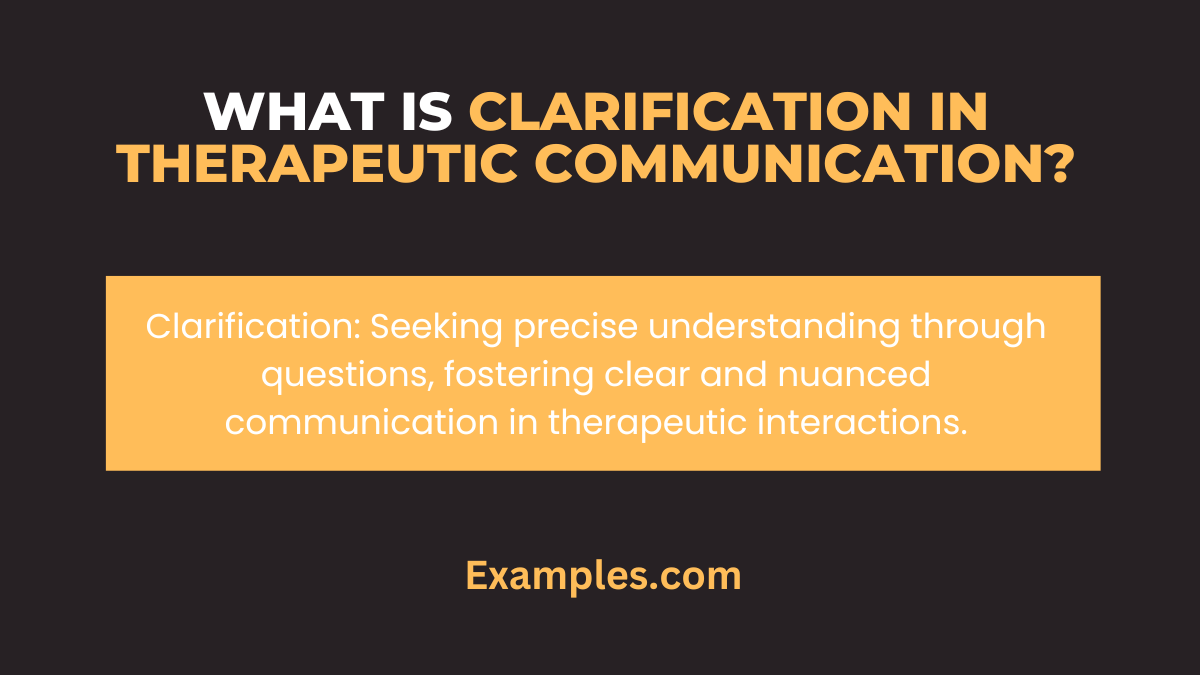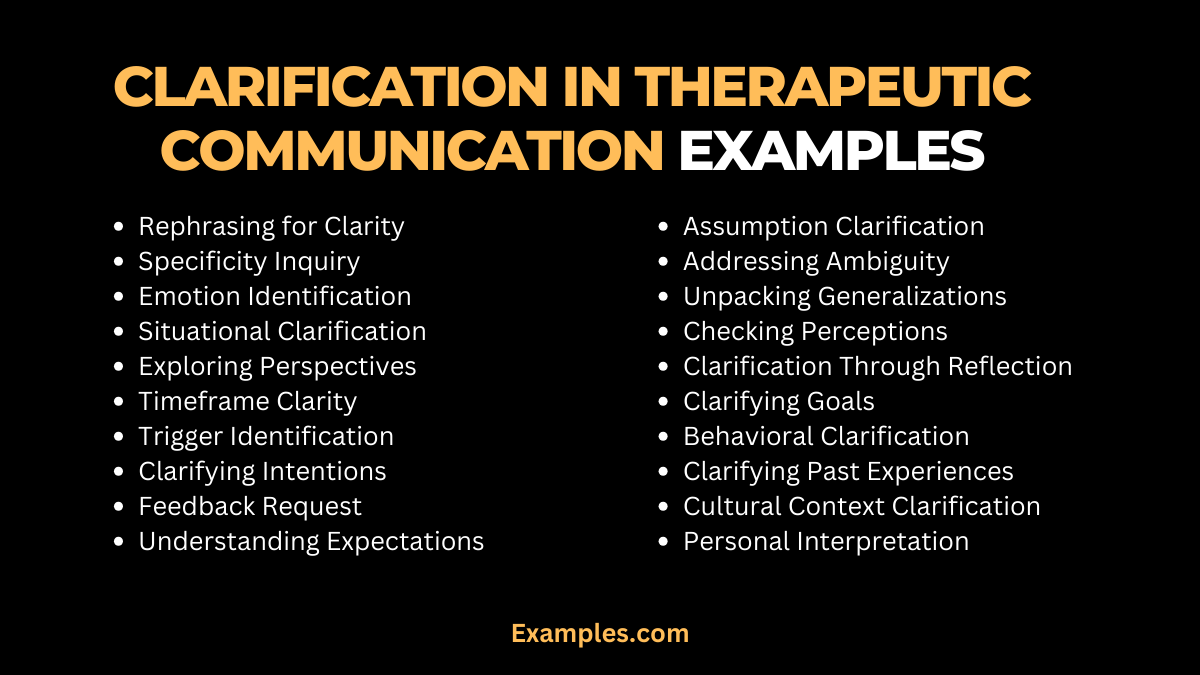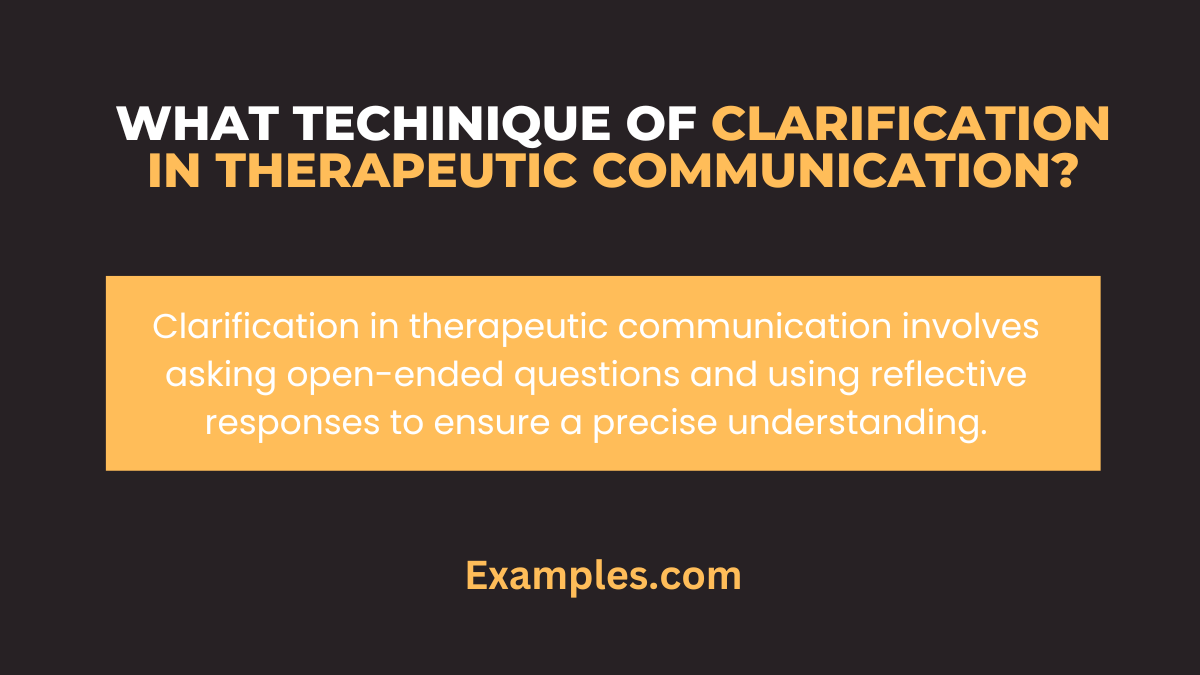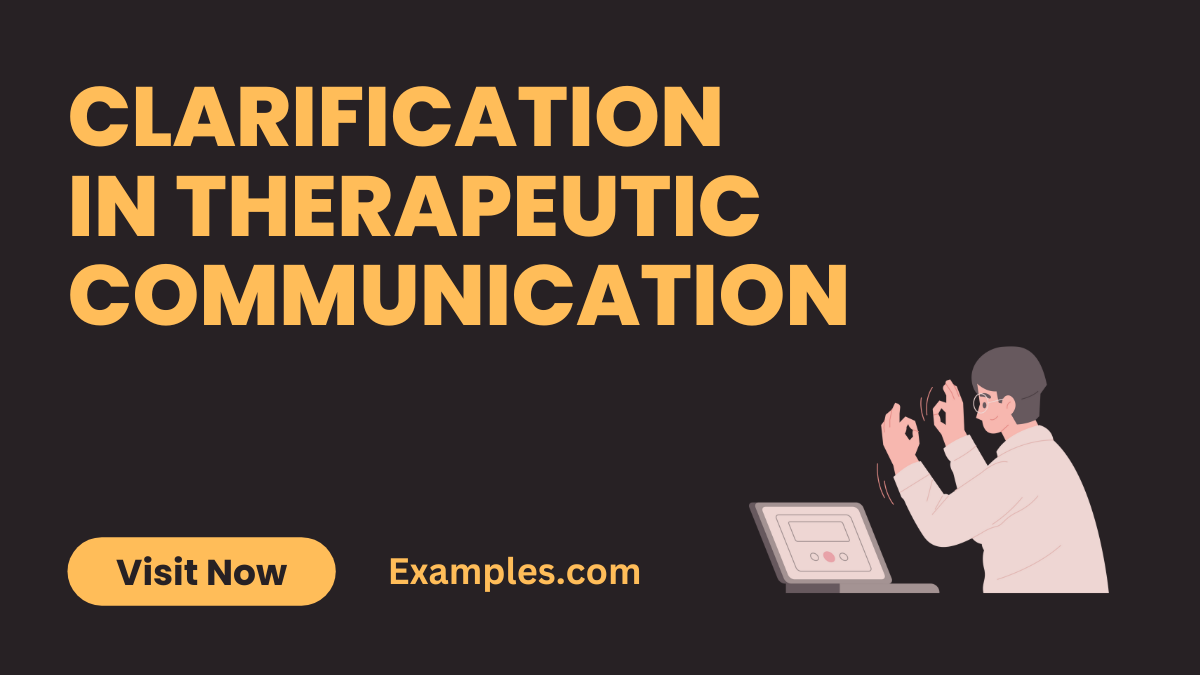19+ Clarification in Therapeutic Communication Examples
Embark on a comprehensive journey through the realm of therapeutic communication as we unveil the complete guide to clarification. Elevate your understanding with vivid communication examples, empowering you to navigate complex dialogues effectively. From unraveling intricacies to fostering genuine connections, this guide equips you with the tools to enhance your therapeutic communication prowess. Join us as we explore the art of clarification and its transformative impact on meaningful interactions in diverse therapeutic settings.
What is Clarification in Therapeutic Communication?

Clarification in therapeutic communication involves seeking further details or ensuring a clear understanding of a client’s message. It aims to eliminate misunderstandings and enhance communication effectiveness by asking for additional information or rephrasing to confirm comprehension.
20 Clarification in Therapeutic Communication Examples

Unveil the power of clarification in therapeutic communication with these 20 practical examples. Navigate complex emotions and enhance understanding through precise questioning and attentive listening. This guide provides insights into fostering meaningful connections in diverse therapeutic settings.
- Rephrasing for Clarity: “So, if I understand correctly, you’re feeling anxious about the upcoming changes?”
- Specificity Inquiry: “Can you provide more details about what you mean by ‘feeling down’?”
- Emotion Identification: “It sounds like you’re expressing frustration. Can you elaborate on the trigger?”
- Situational Clarification: “Help me understand the specific dynamics causing tension in your relationships.”
- Exploring Perspectives: “When you mention ‘struggling,’ are you referring to personal or professional challenges?”
- Timeframe Clarity: “When you say ‘recently,’ can you specify the timeframe you’re referring to?”
- Trigger Identification: “I’m hearing about your discomfort. Can you identify the specific situation triggering it?”
- Clarifying Intentions: “In mentioning ‘improvement,’ can you elaborate on your desired outcomes?”
- Feedback Request: “Am I interpreting your concern correctly, or is there more you’d like to share?”
- Understanding Expectations: “What specific expectations do you have regarding our therapeutic conversations?”
- Assumption Clarification: “I sense some assumptions. Can you clarify what you’re assuming about this situation?”
- Addressing Ambiguity: “Your mention of ‘mixed feelings’ is intriguing. Can we explore these feelings more deeply?”
- Unpacking Generalizations: “When you say ‘always,’ can you provide specific instances for better understanding?”
- Checking Perceptions: “Is my understanding accurate, or is there a different perspective you’d like to highlight?”
- Clarification Through Reflection: “Reflecting on your words, are there additional nuances you’d like to share?”
- Clarifying Goals: “When you mention ‘progress,’ what specific goals are you aiming for?”
- Behavioral Clarification: “You mentioned ‘withdrawal.’ Can you share specific behaviors associated with this?”
- Clarifying Past Experiences: “Your reference to ‘similar situations’ is interesting. Can you recall specific instances?”
- Cultural Context Clarification: “Considering cultural differences, can you help me understand your perspective better?”
- Personal Interpretation: “I’m interpreting your words as a desire for change. Is that an accurate understanding?”
Clarification in Therapeutic Communication Examples For Students
Empower students with the art of clarification in therapeutic communication. Navigate academic challenges with precision, ensuring a clear understanding of their concerns. These examples guide students in fostering effective communication for personal and academic growth.
- Clarifying Academic Goals: “Let’s clarify your academic goals. What specific achievements are you aiming for?”
- Understanding Study Concerns: “Your mention of ‘struggling’ is noted. Can you clarify which aspects of your studies are challenging?”
- Time Management Clarification: “When you say ‘busy,’ can you specify the areas where time management becomes challenging?”
- Expectations Clarification: “In mentioning ‘expectations,’ can you provide more details on what you anticipate?”
- Clarifying Peer Dynamics: “I sense some dynamics with peers. Can you clarify the specific interactions causing discomfort?”
- Exploring Career Goals: “Your aspirations are intriguing. Can you clarify the steps you envision to achieve your career goals?”
- Feedback Request: “Am I understanding your concerns accurately, or is there more you’d like to share?”
- Clarifying Academic Stress: “When you mention ‘stress,’ can you specify if it’s related to exams, assignments, or other factors?”
- Ambition Clarification: “Your mention of ‘ambition’ caught my attention. Can you elaborate on your long-term aspirations?”
- Clarification Through Reflection: “Reflecting on your academic journey, are there specific areas where you seek clarification?”
Clarification in Therapeutic Communication Examples For Patients
Navigate healthcare conversations with precision using clarification in therapeutic communication. These examples guide practitioners in fostering a deeper understanding of patients’ experiences, ensuring personalized and effective care.
- Symptom Clarification: “Let’s clarify your symptoms. Can you provide more details about the intensity and duration?”
- Understanding Treatment Concerns: “Your mention of ‘concerns’ is important. Can you clarify specific aspects of your treatment you’re uneasy about?”
- Medication Clarification: “When you say ‘side effects,’ can you specify which ones you’ve been experiencing?”
- Pain Management Clarification: “I hear you mentioning ‘discomfort.’ Can you clarify the nature and location of your pain?”
- Clarifying Patient History: “Your medical history is crucial. Can you provide additional details or specific events worth noting?”
- Emotional Well-being Clarification: “Your emotional state matters. Can you clarify any emotional challenges you’re currently facing?”
- Exploring Lifestyle Factors: “When mentioning ‘lifestyle,’ can you clarify specific habits or routines affecting your health?”
- Treatment Goals Clarification: “Your treatment goals are essential. Can you provide more details on what you hope to achieve?”
- Family Involvement Clarification: “I sense family is important to you. Can you clarify how you envision their involvement in your care?”
- Cultural Context Clarification: “Considering cultural nuances, can you help me understand your preferences for care better?”
Why Clarification in Therapeutic Communication is Important?
Clarification is paramount in therapeutic communication as it ensures a precise understanding of a client’s expressions. By seeking clarity, practitioners prevent misunderstandings, deepen insights into emotions, and tailor interventions accurately. This process fosters trust, strengthens the therapeutic alliance, and enhances the overall effectiveness of therapeutic interactions.
What is the Technique of Clarification in Therapeutic Communication?

The technique of clarification involves asking open-ended questions and encouraging clients to elaborate on their thoughts and feelings. Practitioners use phrases like “Can you clarify?” or “Tell me more about that” to prompt detailed responses. Reflective listening, paraphrasing, and summarizing are also integral, allowing practitioners to confirm their understanding and explore nuances for more effective communication.
Tips for Effective Clarification in Therapeutic Communications
- Open-Ended Inquiry: Encourage clients to share details by posing open-ended questions.
- Reflective Responses: Repeat and reflect on what clients express to ensure accurate understanding.
- Non-Judgmental Tone: Create a safe space by maintaining a non-judgmental and empathetic demeanor.
- Patience and Silence: Allow pauses for clients to collect their thoughts and express themselves at their own pace.
- Paraphrasing for Confirmation: Rephrase clients’ statements to confirm understanding and provide opportunities for correction.
- Avoid Assumptions: Refrain from making assumptions and seek clarification instead.
- Use of Clear Language: Choose clear and straightforward language to facilitate understanding.
- Clarify Emotions: Explore the depth of emotional expressions to grasp the full spectrum of feelings.
- Tailor Questions: Customize your queries to address specific aspects of clients’ experiences.
- Feedback Loop: Establish a continuous feedback loop, inviting clients to confirm or correct interpretations for ongoing clarity.
In conclusion, mastering the art of clarification in therapeutic communication is pivotal for cultivating understanding and trust. This comprehensive guide has unveiled examples and techniques, empowering practitioners to navigate nuanced dialogues effectively. By fostering precise communication, we create a therapeutic environment where clients feel truly heard, enhancing the therapeutic alliance and contributing to positive outcomes in the healing process.



